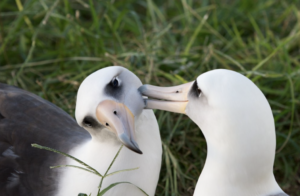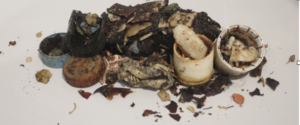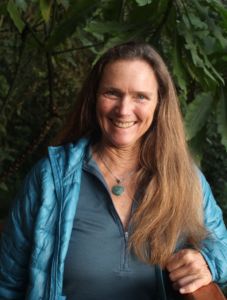Caring Communities: October 2019 Caring for Our Earth Blog

A Laysan albatross pair. Males and females mate for life, and have a ritualized mating dance. They hatch one egg per year, and take turns feeding and sitting on the nest. Flying for many days at a time, the pair gathers food for their young before returning to the nest. Photo credit: Bettina Arrigoni
What’s the big deal about plastic, anyway? you may ask. Many years ago I volunteered with researchers studying the impact of plastics in the ocean. We dissected hundreds of birds that spend their lives flying and feeding in a remote area of the North Pacific Ocean—where very few, if any, people live. Every single bird had chunks of plastic in its stomach! One of the birds I dissected had a large piece of plastic with a sharp edge protruding through its stomach wall. I wondered if that’s what killed it. Sometimes I could identify what the plastic item was, but most often the stomach was filled with tiny fragments of different colored plastic. As I poked through the defrosted bodies of dozens of birds I felt incredible disgust, then deep sadness, followed by a strong determination to make changes.

An albatross bolus is normally filled with squid beaks and other undigestible, but natural material. What plastic items can you identify? https://commons.wikimedia.org/wiki/File:Laysan_albatross_bolus,_Kure_Atoll.JPG
So I developed an environmental science program at the high school where I taught. For one activity my students analyzed the contents of albatross boluses (like an owl pellet—the undigested material that fledglings cough up before they take off on their first flight) collected from tiny islands north of Hawaii, where no people live. The islands are covered in plastic debris, and every albatross bolus had more plastic than natural material. This makes the young birds feel full, though they are getting no nutritive value from what’s filling their stomachs. We were all shocked at how much we found. Plastic is everywhere on our planet, especially suspended near the surface of our oceans, and it’s made to last forever. Does it make any sense to make products from it that are designed to be thrown away after a single use?
Using the Hendricks F.A.C.T. Tool
As you might imagine, facing this reality of what my students and I discovered was painful for all of us. My students were shocked and coped by distracting each other with jokes and teasing, talking about anything but what we had just seen. I wish I’d known about Hendricks tools back then! Maybe I could have helped them face what they experienced more consciously so they could respond in some meaningful way.
Now I practice the F.A.C.T. formula I learned in recent Hendricks’ trainings:
Facing Reality: This is best done while moving—I like to walk around the room at a comfortable pace while letting myself fully feel the feelings in my body. I ask myself, “What have I not been willing to face about my experience and feelings?” Several things popped into my mind: the choices I make create major harmful results for other living beings; sometimes I feel tired of the effort I put out and don’t want people to roll their eyes at my eco-cop persona; and sometimes I’m just lazy and don’t want to deal with all of this anymore; and…. when I looked at all that plastic in those bird stomachs I felt a nauseous sinking sensation in my belly. After watching videos showing birds feeding this stuff to their babies my throat tightened up and burned. I didn’t let myself feel this for too long because it was uncomfortable. My mind numbed out, like I was going to faint, as I envisioned the enormity of the problem, and the sense that the problem was too big for me to do anything about.
Accepting 100% Responsibility: I chose one of the issues to face and hold it in one hand, saying, “I accept that the plastic pollution problem seems so big that I cannot make enough impact to turn it around.” I notice what bubbles up inside me after saying that and look at my other hand to express that, “And I know there are some things I can do that will make a difference, even if they’re small.” I go back and forth from hand to hand as my statements shift until I feel clarity. My statement becomes, “I accept I am not a victim of my culture, but a caring person who has many choices.”
Choosing Aliveness and Making a Commitment: I choose to make decisions when shopping that I feel good about. I commit to making my impact on other living beings a priority in my daily choices.
Take Action: I will look for ways to decrease or eliminate my use of plastics, especially single-use plastic. With practice this process has become almost automatic for me, an easy tool I can try out when I feel stuck or overwhelmed. The first step to transformation often seems to be awareness and commitment to something new. I love the way these steps help me shift into aliveness and clarity for actions I want to take!
In the next newsletter, Plastics Part 2, will feature some great resources on reducing the use of plastics.
Suggested Activity
Give attention to your feelings after viewing these videos. Instead of numbing out, let the impact of this information fully express in your body. What do you notice? Joanna Macy, author and teacher of The Work That Reconnects, emphasizes the importance of letting ourselves feel the depth of our feelings around environmental problems. The uncomfortable pain and sadness is a result of our deep love for our Earth and the living beings we share it with.
When you go shopping slow down and look with curiosity at how many things are packaged in plastic. Wonder at what will happen to all that plastic. Again, notice what happens inside your body. Share your feelings with others.
Here are two Videos that further explore the problems with plastic:
A student analyzes what kinds of plastic ends up in the stomachs of albatrosses and how big the problem is.
This video has some graphic footage of the remains of birds whose stomachs are full of plastic items, similar to the ones I dissected and the boluses my students dissected. It’s hard to watch, but shows what the problem is with our unconscious consumption of plastic materials.
An Inspirational Poem
Though I know there is no “they” to blame for the environmental problems we now face, I love this poem’s reminder of how we all are deeply connected to our natural world…
No Matter How Hard They Try
No matter
how hard they try,
they can not
keep us apart.
They can pour concrete
over the rich, dark earth,
put us in a plastic chair
inside a sheetrock box,
hook us up to electronic devices,
and tell us we have to stay there all day…
and still we will be breathing the breath
of towering pines
growing on rugged mountain slopes
and tiny green plankton
floating in distant seas.
And even though
the water we drink
travels through many miles of pipe,
is doused with chlorine
and may be contained in plastic bottles…
still we will be drinking water
that has tumbled over granite boulders,
hibernated in frozen lakes,
and reflected the morning sun
from a spider’s web.
And even though the salad we eat
may be grown hundreds of miles away,
harvested and washed
by hands we will never see,
and packaged in a plastic box…
still we will be eating
leaves from plants
whose roots embraced the fertile earth
as their tender green bodies reached for the sun.
And no matter how relentlessly
we have been trained
to sit still,
to hold our tongues,
to follow the rules
(even when they make no sense),
still we are animals of flesh and blood,
kin to deer and bear and whale,
with untamed passions in our hearts
and deep wisdom in our bones,
Still there is a wild one inside us,
running barefoot through the forest,
gathering sweet berries,
dancing around the fire,
praying to the sun,
singing to the moon.
From Poems of Earth and Spirit: 70 Poems and 40 Practices to Deepen Your Connection with Nature by Kai Siedenburg http://ournatureconnection.com/writings/poems-earth-spirit-book

About the Author
My goal is to inspire people to join the growing movement of game changers taking big and small steps toward creating a more environmentally sustainable human presence on our Earth, our Home. Each month will include educational videos, feature an inspiring solution-oriented person or organization, and provide helpful tips for you to Do One Thing (your DOT) to help us get there. Writing this newsletter is my DOT. I feel joyful and in ease and flow when I include Genius skills in choosing my DOT. I hope readers will be inspired to do the same!
In the midst of a major life transition, Tamara lives a somewhat nomadic life—traveling in her Westfalia camper van when she’s not renting a house in the high lonesome desert near Death Valley, California. She devotes her time to exploring the wilderness of the Eastern Sierra Nevada Mountains, writing, practicing Qi Gong, and learning new life skills with the Leadership and Transformation program of the Hendricks Institute. As a certified Big Leap Home coach, she inspires others to live a life of joy and authenticity, untethered by fear or societal expectations. Her passions are being in nature, learning more about sustainable ways of sharing our Earth with other living beings, and adventuring with her adult children and 4-legged companion, Riley. You can follow her blog at: https://wanderingwithwanda.com/


